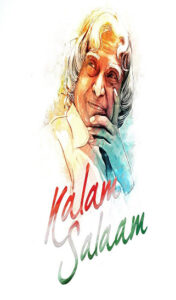 Avul Pakir Jainulabdeen Abdul Kalam (October 15, 1931 – July 27, 2015) was an Indian aerospace scientist who served as the 11th President of India from 2002 to 2007.
Avul Pakir Jainulabdeen Abdul Kalam (October 15, 1931 – July 27, 2015) was an Indian aerospace scientist who served as the 11th President of India from 2002 to 2007.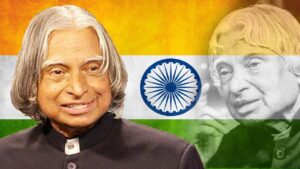
Avul Pakir Jainulabdeen Abdul Kalam was born and raised in Rameswaram, Tamil Nadu and studied aerospace physics and engineering.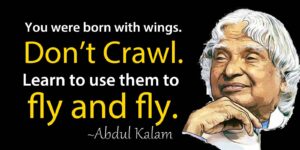
Personal life:
Kalam was the youngest of five siblings, the oldest of whom was a sister.
Kalam was noted for his integrity and his simple lifestyle.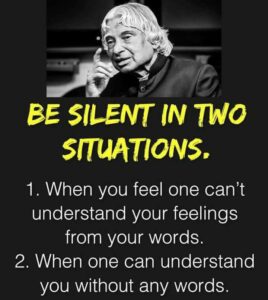
Kalam’s few personal possessions included his books, his veena, some clothing, a CD player, and a laptop.
Religion and spirituality were very important to Kalam throughout his life.
Avul Pakir Jainulabdeen Abdul Kalam spent the next four decades as a scientist and science administrator, primarily with the Defense Research and Development Organization (DRDO) and the Indian Space Research Organization (ISRO) and was intimately involved in the civilian space program. of India and in military missile development efforts.
Avul Pakir Jainulabdeen Abdul Kalam became known as the Missile Man of India for his work on ballistic missile development and launch vehicle technology.
Avul Pakir Jainulabdeen Abdul Kalam also played a key organizational, technical and political role in India’s Pokhran-II nuclear tests in 1998, the first since India’s original nuclear test in 1974.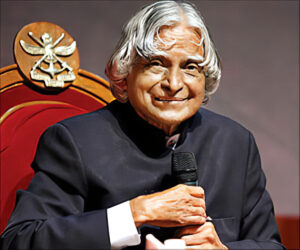
Kalam was elected as the 11th president of India in 2002 with the support of both the ruling Bharatiya Janata Party and the then-opposition Indian National Congress.
Widely known as the “president of the people”, Avul Pakir Jainulabdeen Abdul Kalam returned to his civilian life of education, writing and public service after a single term.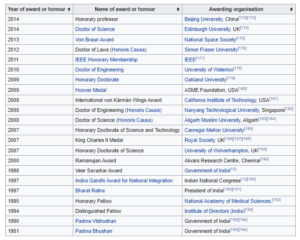
Avul Pakir Jainulabdeen Abdul Kalam received several prestigious awards, including the Bharat Ratna, India’s highest civil honor.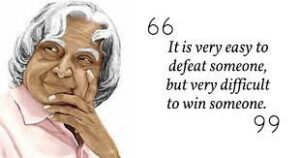
While lecturing at the Indian Institute of Management in Shillong, Kalam collapsed and died of apparent cardiac arrest on July 27, 2015, at the age of 83.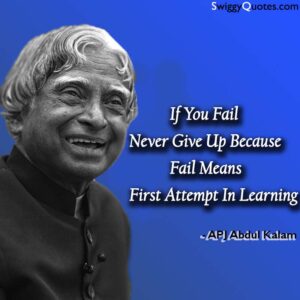
Early age and education:
Avul Pakir Jainulabdeen Abdul Kalam was born on October 15, 1931, to a Tamil Muslim family in the Rameswaram pilgrimage centre on the island of Pamban, then in the Madras presidency and now in the state of Tamil Nadu. Avul Pakir Jainulabdeen Abdul Kalam’s father, Jainulabdeen Marakayar, owned a boat and imam of a local mosque.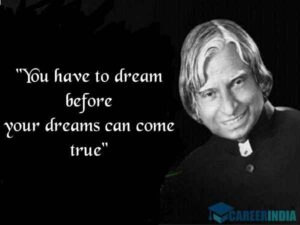
Avul Pakir Jainulabdeen Abdul Kalam’s mother, Ashiamma, was a homemaker.
Avul Pakir’s father Jainulabdeen Abdul Kalam owned a ferry that carried Hindu pilgrims back and forth between Rameswaram and the now uninhabited Dhanushkodi.
Avul Pakir Jainulabdeen Abdul Kalam was the youngest of four brothers and a sister in his family.
Avul Pakir Jainulabdeen Abdul Kalam’s ancestors had been wealthy Marakayar merchants and landowners, with numerous estates and large tracts of land.
Although Avul Pakir Jainulabdeen Abdul Kalam’s ancestors had been wealthy Marakayar merchants, the family had lost most of its fortunes in the 1920s and was mired in poverty when Kalam was born.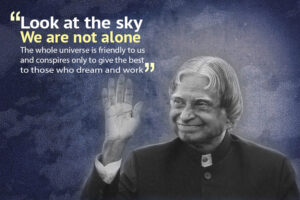
Marakayar is a Muslim ethnic group found on the coast of Tamil Nadu and Sri Lanka and claiming to be the descendants of Arab merchants and local women.
Avul Pakir Jainulabdeen Abdul Kalam business had involved the grocery trade between the mainland and the island and to and from Sri Lanka, as well as the transport of pilgrims between the mainland and Pamban.
As a child, Avul Pakir Jainulabdeen Abdul Kalam had to sell newspapers to increase the family’s meagre income.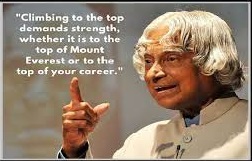
However, with the opening of the Pamban Bridge to the mainland in 1914, businesses failed and family fortune and property were eventually lost, in addition to the ancestral home.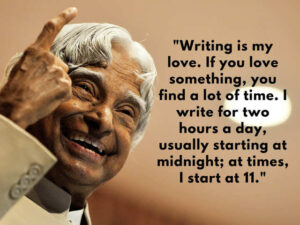
In his school years, Kalam earned average grades but was described as a bright, hardworking student who had a strong desire to learn.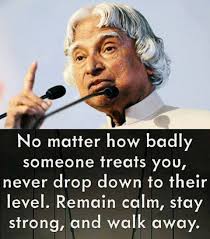
Avul Pakir Jainulabdeen Abdul Kalam devoted hours to his studies, especially mathematics.
After completing his education at Schwartz Upper Secondary School, Ramanathapuram, Kalam attended Saint Joseph’s College, Tiruchirappalli, then affiliated with the University of Madras, where Avul Pakir Jainulabdeen Abdul Kalam graduated in physics in 1954.
Avul Pakir Jainulabdeen Abdul Kalam moved to Madras in 1955 to study aerospace engineering at the Madras Institute of Technology.
While Kalam was working on a senior class project, the Dean was dissatisfied with his lack of progress and threatened to revoke his scholarship unless the project was completed within the next three days.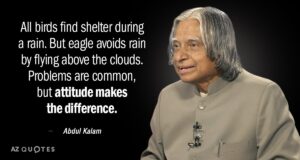
Avul Pakir Jainulabdeen Abdul Kalam almost did not achieve his dream of becoming a fighter pilot, as Avul Pakir Jainulabdeen Abdul Kalam placed ninth in the qualifiers and only eight positions were available in the IAF.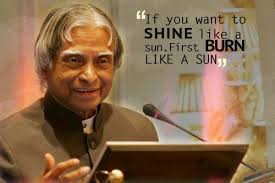
Career as a scientist:
- After graduating from Madras Institute of Technology in 1960, Kalam joined the Aeronautical Development Establishment of the Defense Research and Development Organization (by the Press Information Office, Government of India) as a scientist after becoming a member. Defense Research and Development Service (DRDS). ).
- After graduating from the Madras Institute of Technology in 1960, Kalam joined the Aeronautical Development Establishment of the Defense Research and Development Organization as a scientist after becoming a member of the Defense Research and Development Service (DRDS).
- Kalam started his career designing a small hovercraft but was not convinced by his choice of a job at DRDO.
- Kalam was also part of the INCOSPAR committee that works with Vikram Sarabhai, the renowned space scientist.
- In 1969, Kalam was transferred to the Indian Space Research Organization (ISRO), where he was project manager for India’s first Satellite Launch Vehicle (SLV-III) that successfully deployed the Rohini satellite into orbit near Earth in July 1980.
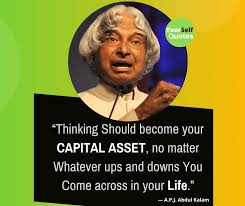
Pokhran-II:
- The Pokhran-II tests were a series of five nuclear bomb test explosions conducted by India at the Indian Army’s Pokhran Proving Ground in 1998.
- It was the second nuclear test conducted by India; The first test, codenamed the Smiling Buddha, was carried out in 1974.
- The tests achieved their primary goal of giving India the ability to manufacture fission and thermonuclear weapons with yields of up to 200 kilotons.
- Pokhran-II consisted of five detonations, the first of which was a fusion bomb, while the remaining four were fission bombs.
- The tests began on May 11, 1998, under the assigned code name Operation Shakti, with the detonation of a fusion and two fission bombs.
- The tests resulted in a variety of sanctions against India by several major states, including Japan and the United States.
- Many names have been assigned to these tests; originally these were collectively called Operation Shakti-98, and the five nuclear bombs were designated Shakti-I through Shakti-V.
- The operation as a whole is known as Pokhran II and the 1974 explosion as Pokhran-I.
- The government continued to deny requests for additional nuclear tests after Prime Minister Indira Gandhi saw that Pakistan began to act in a risky manner, although the nuclear program continued to advance.
- The work for the hydrogen bomb, as well as the launch of the missile program, began with Dr. Abdul Kalam, who was then an aerospace engineer.
- Consultation between Prime Minister Vajpayee, Dr. Abdul Kalam, R. Chidambaram and DAE officials of India on nuclear options was initiated.
- Chidambaram briefed Prime Minister Vajpayee extensively on the nuclear program; Abdul Kalam presented the status of the missile program.
- In 1998, Prime Minister Vajpayee asked scientists to make preparations in the shortest possible time, and the preparations were made hastily.
- The chief scientific advisor and director of the Defense Research and Development Organization (DRDO), Dr. Abdul Kalam, and Dr. R. Chidambaram, director of the Department of Atomic Energy (DAE), were the main coordinators of this planning of tests.
- Scientists and engineers from the Bhabha Atomic Research Center (BARC), the Atomic Minerals Research and Exploration Directorate (AMDER) and the Defense Research and Development Organization (DRDO) were involved in the assembly, design, detonation and collection of nuclear weapons data.
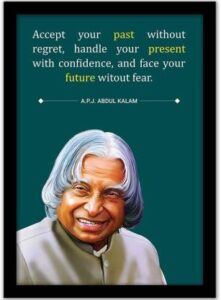
Designs and development of nuclear weapons:
- Development and test teams.
- The main technical personnel involved in the operation were:
- Project Lead Coordinators:
- Dr. A.P.J. Abdul Kalam (later President of India), Scientific Advisor to the Prime Minister and Director of the DRDO.
- Dr. R. Chidambaram, President of the Atomic Energy Commission and the Department of Atomic Energy.Defense Research and Development Organization (DRDO):
- Dr. K. Santhanam; Director, Test Site Preparations.Atomic Minerals Exploration and Research Directorate:
- Dr. G. R. Dikshitulu; Senior Scientific Researcher of the B.S.O.I Group, Acquisition of Nuclear Materials.Bhabha Atomic Research Center (BARC)
- Dr. Anil Kakodkar, Director of BARC.
- Dr. Satinder Kumar Sikka, Director; Development of thermonuclear weapons.
- Dr. M. S. Ramakumar, Director of the Nuclear Fuel and Automation Manufacturing Group; Director, Manufacture of Nuclear Components.
- Dr. D.D. Sood, Director of the Radiochemistry and Isotopes Group; Director of Acquisition of Nuclear Materials.
- Dr. S.K. Gupta, Solid State Physics and Spectroscopy Group; Director, Design and Evaluation of Devices.
- Dr. G. Govindraj, Associate Director of the Instrumentation and Electronics Group; Director, Field Instrumentation.
- Kalam had started work on an independently expandable rocket project at DRDO in 1965.
- From 1963 to 1964, Kalam visited NASA’s Langley Research Center in Hampton, Virginia; The Goddard Space Flight Center in Greenbelt, Maryland; and the Wallops Flight Facility.
- Between the 1970s and 1990s, Kalam made an effort to develop the Polar Satellite Launch Vehicle (PSLV) and SLV-III projects, which proved successful.
- In the 1970s, Kalam also led two projects, Project Devil and Project Valiant, which sought to develop ballistic missiles from technology from the successful SLV program.
- Despite the disapproval of the Union Cabinet, Prime Minister Indira Gandhi allocated secret funds for these aerospace projects through her discretionary powers under the direction of Kalam.
- Kalam played an integral role in convincing the Union Cabinet to hide the true nature of these classified aerospace projects.
- Kalam Research and his educational leadership brought him great laurels and prestige in the 1980s, prompting the government to initiate an advanced missile program under his leadership.
- Kalam and Dr. VS Arunachalam, metallurgist and scientific advisor to the Minister of Defense, worked at the suggestion of the then Minister of Defense, R. Venkataraman, on a proposal for the simultaneous development of a missile quiver instead of taking planned missiles one After another.
- R. Venkatraman was instrumental in obtaining cabinet approval to allocate ₹ 3.88 billion for the mission, dubbed the Integrated Guided Missile Development Program (IGMDP), and appointed Kalam as executive director.
- Kalam played an important role in the development of many missiles under the mission, including Agni, an intermediate-range ballistic missile, and Prithvi, the tactical surface-to-surface missile, although the projects have been criticized for mismanagement and cost and time overruns.
- Kalam served as Chief Scientific Adviser to the Prime Minister and Secretary for Defense Research and the Pokhran-II nuclear tests were carried out during this period in which he played an intensive political and technological role.
- Kalam served as Chief Project Coordinator, along with Rajagopala Chidambaram, during the testing phase.
- Kalam’s media coverage during this period made him the best-known nuclear scientist in the country.
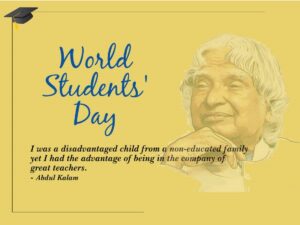
Kalam Concerned about people:
- “Dr. Kalam was always eager and willing to support discussions and events related to the rights and needs of Persons with Disabilities.”
- In 1998, together with cardiologist Soma Raju, Kalam developed a low-cost coronary stent, called the “Kalam-Raju Stent.”
- Former President A.P.J. Abdul Kalam was concerned about people with disabilities and, together with his team, developed lightweight prosthetics from space-age material to allow disabled children to walk with ease.
- Kalam was not only an inspiration to the young generation but also a supporter of people with disabilities.
- “The Bharat Ratna awardee and his team developed lightweight prosthetics from space-age materials to allow children with disabilities to walk.
- He expressed his joy at seeing the children run and ride their bikes using these lightweight artificial limbs.
- “When I see children running and cycling with the artificial limbs we designed, it is a real joy,” Kalam said while delivering the 12th convocation speech of the Dr. MGR Medical University of Tamil Nadu in 2010.
- “I had seen these children wrestling with artificial limbs that weighed at least 4 kg.
- My team made one out of thermal composites used for rockets. This one is 10 times lighter. ”
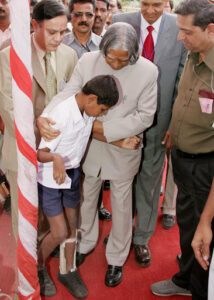
THE PRESIDENT DR APJ ABDUL KALAM MEETING PHYSICALLY CHALLENGED CHILDREN DURING HIS VISIT TO VILLAGE LONI IN MAHARASHTRA. - In 2012, the duo designed a rugged tablet for health care in rural areas, which was named the “Kalam-Raju Tablet”.
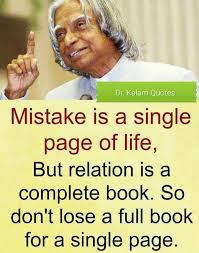
- Presidency:
- Kalam served as the 11th President of India, succeeding K. R. Narayanan.
- Kalam won the 2002 presidential elections with an electoral vote of 922,884, surpassing the 107,366 votes obtained by Lakshmi Sahgal.
- Kalam’s tenure lasted from July 2002 to July 2007.
- In 2002, the National Democratic Alliance (NDA), which was in power at the time, said that they would nominate Kalam for the position of president and both the Samajwadi Party and the National Congress Party endorsed his candidacy.
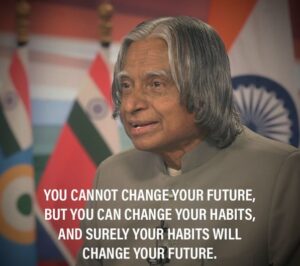
Kalam said of the announcement of his candidacy:
- Kalam presented his nomination papers in the Indian Parliament, accompanied by Vajpayee and his senior cabinet colleagues.
- Kalam along with Vladimir Putin and Manmohan Singh during his presidency.
- Kalam became the 11th President of the Republic of India with an easy victory and moved to Rashtrapati Bhavan after Kalam was sworn in on July 25.
- Kalam was the third President of India to have been honored with a Bharat Ratna, India’s highest civil honor, before becoming President Sarvepalli Radhakrishnan (1954) and Zakir Hussain (1963) were the first recipients of Bharat Ratna, who later became the president of India.
- Kalam was also the first scientist and the first bachelor to occupy Rashtrapati Bhawan.
- During his tenure as president, Kalam was affectionately known as the people’s president, and he said that signing the Benefits Office bill was the most difficult decision Kalam had made during his tenure.
- Kalam was criticized for his inaction in deciding the fate of 20 of the 21 clemency petitions presented to him during his tenure.
- Article 72 of the Constitution of India empowers the President of India to grant pardons and suspend or commute the death sentence of those convicted on death row.
- Kalam acted on only one clemency petition in his five-year term as president, rejecting the petition of rapist Dhananjoy Chatterjee, who was later hanged.
- Perhaps the most notable statement was that of Afzal Guru, a Kashmiri terrorist who was convicted of conspiracy in the December 2001 attack on the Indian Parliament and was sentenced to death by the Supreme Court of India in 2004.
- Kalam also made the controversial decision to impose the rule of the president in Bihar in 2005.
- In 2003, in an interactive session at PGI Chandigarh, Kalam supported the need for a Uniform Civil Code in India, taking into account the population of the country.

Post-presidency:
- Kalam became a visiting professor at the Indian Institute of Management Shillong,
- Indian Institute of Management Ahmedabad, and Indian Institute of Indore Management; Honorary Member of the Indian Institute of Sciences, Bangalore; Chancellor of the Indian Institute of Space Science and Technology Thiruvananthapuram.
- Professor of Aerospace Engineering at Anna University; and an adjunct in many other academic and research institutions throughout India.
- Kalam taught information technology at the International Institute of Information Technology, Hyderabad, and technology at Banaras Hindu University and Anna University.
- In 2011, Kalam was criticized by civil groups for his position at the Koodankulam nuclear power plant.
- Kalam supported the establishment of the nuclear power plant and was accused of not speaking to the local population.
- In 2012, Kalam launched a program for young people in India called the What Can I Give Movement, with a central theme of defeating corruption.
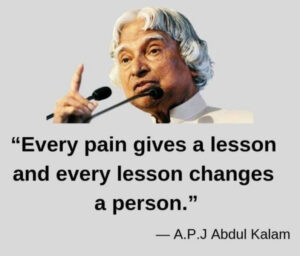
Moment of Tears:
- In 2015, Kalam travelled to Shillong to give a lecture on “Creating a livable planet Earth” at the Indian Institute of Management in Shillong.
- While lecturing at the Indian Institute of Management in Shillong, Kalam collapsed and died of apparent cardiac arrest on July 27, 2015, at the age of 83.

Condolences:
- India reacted to Kalam’s death with a torrent of pain; Numerous tributes were paid to the former president across the country and on social media.
- South Asian leaders expressed their condolences and praised the late statesman.
- Bhutan Prime Minister Tshering Tobgay expressed his deep sadness, saying that Kalam “was a leader highly admired by all people, especially the youth of India, who has referred to him as the president of the people.”
- Bangladeshi Prime Minister Sheikh Hasina described Kalam as “a rare combination of a great statesman, an acclaimed scientist and a source of inspiration to the young generation of South Asia” and called his death an “irreparable loss to India and beyond “.
- The head of the Bangladesh Nationalist Party, Khaleda Zia, said that “as a nuclear scientist, he was committed to the welfare of the people.”
- Ashraf Ghani, the president of Afghanistan, called Kalam “an inspiring figure for millions of people” and noted that “we have a lot to learn from his life.”
- Nepalese Prime Minister Sushil Koirala recalled Kalam’s scientific contributions to India:
- Pakistani President Mamnoon Hussain and Pakistani Prime Minister Nawaz Sharif also expressed their grief and condolences at his death.
- Sri Lankan President Maithripala Sirisena also expressed his condolences.
- Dr. Kalam was a man of firm conviction and indomitable spirit.
- Maldivian President Abdulla Yameen and Vice President Ahmed Adeeb condemned Kalam’s death, and Yameen named him as a close friend of the Maldives who would continue to be an inspiration to Indians and generations of South Asians.
- Former President Maumoon Abdul Gayoom, who had paid an official visit to India during the Kalam presidency, called his disappearance a great loss to all mankind.
- The Commander-in-Chief of the Myanmar Armed Forces, Senior General Min Aung Hlaing, expressed his condolences on behalf of the Myanmar government.
- The Dalai Lama expressed his sadness and offered condolences and prayers, calling Kalam’s death “an irreparable loss.”
- Kathleen Wynne, the prime minister of Ontario, whom Kalam had visited numerous times, expressed “her deepest condolences to her as a respected scientist, as kalam played a pivotal role in the development of the Indian space program.”
- US President Barack Obama expressed “his deepest condolences to the people of India on the passing of the former President of India, Dr. APJ Abdul Kalam,” and highlighted his achievements as a scientist and statesman, in particular his role in strengthening US-Indian relations and increasing space cooperation between the two nations.
- “Properly named ‘President of the People, Dr. Kalam’s humility and dedication to public service served as an inspiration to millions of Indians and fans around the world.
- Russian President Vladimir Putin expressed his sincere condolences and conveyed his sympathy and support “to the near and dear ones of the late leader, the government and the entire people of India.”
- International leaders including former Indonesian President Susilo Bambang Yudhoyono,
- Prime Minister of Malaysia Najib Razak,
- Prime Minister of Singapore Lee Hsien Loong,
- President of the United Arab Emirates, Sheikh Khalifa bin Zayed Al Nahyan, and the Vice President and Prime Minister of the United Arab Emirates and the Emir. of Dubai, Sheikh Mohammed bin Rashid Al Maktoum also paid tribute to Kalam.
- Monuments:
- The Dr. A. P. J. Abdul Kalam National Memorial was built in memory of Kalam by the DRDO at Pei Karumbu, in the island town of Rameswaram, Tamil Nadu.

- The Dr. A. P. J. Abdul Kalam National Monument was inaugurated by Prime Minister Narendra Modi in 2017. Acrylic paintings about his life are also on display along with hundreds of portraits depicting the life of the mass leader.
- A statue of Kalam at the entrance showing him playing the Veena.
- There are two other smaller statues of the leader sitting and standing.
- Construction of the Dr. A. P. J. Abdul Kalam City of Science started in Patna in 2019.
- A new science and planetarium center in Lawspet, Puducherry.
- India and the USA launched the Fulbright-Kalam Climate Scholarship in September 2014.
- The first call for applicants was announced in 2016, for the scholarship that will allow up to 6 Indian Ph.D. students and post-doctoral researchers to work with host US institutions for a period of 6-12 months.
- The scholarship will be operated by the United States-India Binational Educational Foundation (USIEF) under the Fulbright program.
- Dr. APJ Abdul Kalam Planetarium in Burla, Sambalpur, Odisha was named after Kalam.
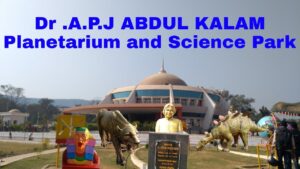
Syncretism:
- The wide popularity of Kalam among various groups in India, and an enduring aspect of his legacy, is syncretism.
- kalam embodied in the appreciation of various elements of the many spiritual and cultural traditions of India.
- Kalam also enjoyed writing Tamil poetry, playing the veena (an ancient Indian stringed instrument), and listening to Carnatic devotional music every day.
- In 2002, in his first speeches before Parliament after becoming president, Kalam reiterated his desire for a more united India.
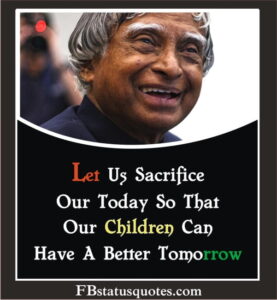
Writings:
- Kalam took an active interest in other developments in the field of science and technology, including a research program for the development of biomedical implants.
- Kalam also supported open source technology over proprietary software, predicting that the use of free software on a large scale would bring the benefits of information technology to more people.
- Kalam set a goal of interacting with 100,000 students during the two years after he resigned from the position of scientific advisor in 1999.

Awards and distinctions:
- Kalam received 7 honorary doctorates from 40 universities.
- The Government of India honored Kalam with Padma Bhushan in 1981 and Padma Vibhushan in 1990 for his work with ISRO and DRDO and his role as scientific advisor to the Government.
- In 1997, Kalam received India’s highest civilian honor, the Bharat Ratna, for his contribution to scientific research and modernization of defense technology in India.
- In 2013, Kalam received the Von Braun Award from the National Space Society “to recognize excellence in the management and leadership of a space-related project.”
- In 2012, Kalam was ranked # 2 in Outlook India’s survey of the largest Indians.
- After his death, Kalam received numerous tributes.
- The Tamil Nadu state government announced that his birthday, October 15, would be celebrated across the state as “Youth Rebirth Day”; the state government also instituted the “Dr. A. P. J. Abdul Kalam Award”, which is an 8 gram gold medal, a certificate and ₹ 500,000 (US $ 6,600).
- The award will be awarded annually on Independence Day, beginning in 2015, to residents of the state with achievements in promoting scientific growth, the humanities, or the well-being of students.
- On the anniversary of Kalam’s birth in 2015, CBSE set topics about his name in the CBSE series of expressions.
- Prime Minister Narendra Modi ceremonially released postage stamps commemorating Kalam at DRDO Bhawan in New Delhi on October 15, 2015, the 84th anniversary of Kalam’s birth.
- Researchers at NASA’s Jet Propulsion Laboratory (JPL) had discovered a new bacterium on the filters of the International Space Station (ISS) and named it Solibacillus kalam in honor of the late President Dr. A. P. J. Abdul Kalam.
- Various educational and scientific institutions and other places were renamed or named after Kalam after his death.
- Kerala University of Technology, based in Thiruvananthapuram, where Kalam lived for years, was renamed A P J Abdul Kalam University of Technology after his death.
- An agricultural university in Kishanganj, Bihar, was renamed “Dr. Kalam Agricultural University, Kishanganj” by the Bihar state government on the day of Kalam’s funeral.
- The state government also announced that it would name a proposed science city after Kalam.
- The First Institute of Medical Technology of India is called Kalam Institute of Health Technology, located in Visakhapatnam.
- Uttar Pradesh Technical University (UPTU) was renamed A. P. J. Abdul Kalam Technical University by the Uttar Pradesh state government.
- A. P. J. Abdul Kalam Memorial Travancore Institute of Digestive Diseases, a new research institute in the city of Kollam, Kerala attached to Travancore Medical College Hospital.
- A new academic complex at Mahatma Gandhi University in Kerala.
- Construction of the Dr. A. P. J. Abdul Kalam City of Science started in Patna in 2019.
- A new science and planetarium centre in Lawspet, Puducherry.
- India and the USA launched the Fulbright-Kalam Climate Scholarship in September 2014.
- The first call for applicants was announced in 2016, for the scholarship that will allow up to 6 Indian Ph.D. students and post-doctoral researchers to work with host US institutions for a period of 6-12 months.
- The scholarship will be operated by the United States-India Binational Educational Foundation (USIEF) under the Fulbright program.
- Dr. APJ Abdul Kalam Planetarium in Burla, Sambalpur, Odisha was named after him.
Island:
- Wheeler Island, a national missile test site in Odisha, was renamed Abdul Kalam Island in September 2015.
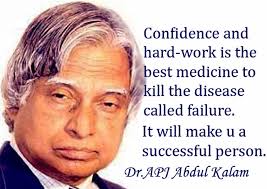
Road:
- In August 2015, a major highway in New Delhi was renamed from Aurangzeb Road to Dr APJ Abdul Kalam Road.
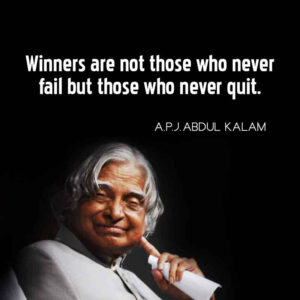
Plant species:
- In 2018, scientists from the Botanical Survey of India named a newly discovered plant species Drypetes kalam, in his honor.

Awards and honors:
Year of award or honor Name of award or honor Awarding organization
- 2014 Honorary Professor of Beijing University, China
- 2014 Doctor of Science from the University of Edinburgh, UK
- 2013 Von Braun National Space Society Award
- 2012 Doctor of Laws (Honoris Causa) Simon Fraser University
- 2011 IEEE IEEE Honorary Membership
- 2010 Ph.D. in Engineering from the University of Waterloo
- 2009 Honorary Doctorate from Oakland University
- 2009 Hoover Medal ASME Foundation, USA
- 2009 von Kármán Wings International Award California Institute of Technology, USA.
- 2008 Doctor of Engineering (Honoris Causa) Nanyang Technological University, Singapore
- 2008 Doctor of Science (Honoris Causa) Muslim University of Aligarh, Aligarh
- 2007 Honorary Doctorate in Science and Technology Carnegie Mellon University
- 2007 King Carlos II Royal Society Medal, United Kingdom
- 2007 Honorary Doctorate of Science from the University of Wolverhampton, UK
- 2000 Ramanujan Award Alwars Research Center, Chennai
- 1998 Veer Savarkar Award Government of India
- 1997 Indira Gandhi Award for National Integration Indian National Congress
- 1997 Bharat Ratna President of India
- 1995 Honorary Member of the National Academy of Medical Sciences,
- 1994 Distinguished Fellow Institute of Directors (India)
- 1990 Padma Vibhushan Government of India
- 1981 Padma Bhushan Government of India
Legacy:
- Main article: List of things named after A. P. J. Abdul Kalam.
- Books, documentaries and popular culture.

Kalam’s writings:
- Developments in Fluid Mechanics and Space Technology by A P J Abdul Kalam and Roddam Narasimha; Indian Academy of Sciences, 1988
- India 2020: A Vision for the New Millennium by A P J Abdul Kalam, Y. S. Rajan; New York, 1998.
- Wings of Fire: An Autobiography by AP J Abdul Kalam, Arun Tiwari; University Press, 1999.
- Fired Minds: Unleashing Power Within India by A P J Abdul Kalam; Viking, 2002.
- The luminous sparks of A P J Abdul Kalam, from; Punya Publishing Pvt Ltd., 2004.
- Mission India by A P J Abdul Kalam, paintings by Manav Gupta; Penguin Books, 2005
- Inspirational Thoughts from A P J Abdul Kalam; Rajpal & Sons, 2007
- Indomitable Spirit of A P J Abdul Kalam; Rajpal and Sons Publishing
- Visualizing a Nation Empowered by A P J Abdul Kalam with A Sivathanu Pillai; Tata McGraw-Hill, New Delhi.
- You are born to flourish: Take my journey beyond AP J Abdul Kalam and Arun Tiwari; Ocean Books, 2011.
- Tipping Points: A Journey Through Challenges by A P J Abdul Kalam; Harper Collins India, 2012.
- Target 3 billion by A P J Abdul Kalam and Srijan Pal Singh; December 2011 | Editorial Penguin Books.
- My Journey: Turning Dreams Into Actions by A P J Abdul Kalam; 2014 by Rupa Publication.
- A Manifesto for Change: India 2020 Sequel by A P J Abdul Kalam and V Ponraj; 2014 by Harper Collins.
- Shape Your Future: Sincere, Frank, Inspiring by A P J Abdul Kalam; by Rajpal and Sons, 2014.
- Reignited: Scientific Pathways to a Brighter Future by AP J Abdul Kalam and Srijan Pal Singh; by Penguin India, 2015.
- Transcendence: My Spiritual Experiences with Pramukh Swamiji by A P J Abdul Kalam with Arun Tiwari; HarperCollins Publishers, June 2015
- Advantage India: From Challenge to Opportunity by A P J Abdul Kalam and Srijan Pal Singh; HarperCollins Publishers, October 15, 2015.
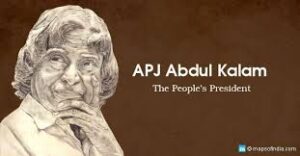
Biographies:
- Eternal Quest: Life and Times of Dr Kalam by S Chandra; Pentagon Editors, 2002.
- President A P J Abdul Kalam by R K Pruthi; Anmol Publications, 2002.
- A P J Abdul Kalam: The Visionary of India by K Bhushan, G Katyal; A P H Pub Corp, 2002.
- A little dream (documentary) by P. Dhanapal; Minveli Media Works Private Limited, 2008.
- The Kalam Effect: My Years with the President by P M Nair; Harper Collins, 2008.
- My Days With Mahatma Abdul Kalam by Fr. A K George; Novel Corporation, 2009.
- A.P.J. Abdul Kalam: A Life by Arun Tiwari; Haper Collins, 2015.
- The village president: Dr. A P J Abdul Kalam by S M Khan; Bloomsbury Publication, 2016.
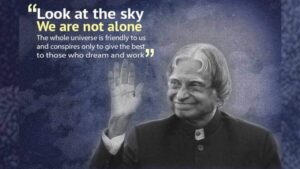
Popular culture:
- In the 2011 Hindi film I Am Kalam, Kalam is portrayed as a positive influence on a poor but brilliant Rajasthani boy named Chhotu, who renames himself, Kalam, after his idol.
- My Hero Kalam is a 2018 Kannada Indian language biographical film by Shivu Hiremath that portrays his life from childhood to Pokhran’s trials.
- People’s President is a 2016 Indian documentary feature film directed by Pankaj Vyas that covers the life of Kalam.
- It was produced by the Film Division of the Government of India.
- Mega Icons (2018-2020), a documentary television series about prominent Indian personalities that aired on National Geographic, based the third episode, “APJ Abdul Kalam,” on Kalam’s life and descent into the presidency. from India.
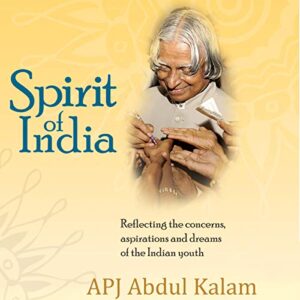
- The Dr. A. P. J. Abdul Kalam National Memorial was built in memory of Kalam by the DRDO at Pei Karumbu, in the island town of Rameswaram, Tamil Nadu.

